Background
- DeepWalk/Node2vec属于shallow encoding,有如下优缺点:
- 需要O(|V|)的参数量,节点间的embedding不共享,每个node有独立的embedding
- 推导式的(transductive):training时没有的node,不会有embedding
- 没有利用到节点的特征,只利用了graph structure
- 范式:
- encoder生成node embedding,DeepWalk&Node2vec中为一个|V|*D的权重矩阵:
- decoder将node embedding映射回原空间,这里存在隐式的decoder,embedding空间两向量的点积可以表示原空间u,v的相似度:
- GNN: deep encoding
- encoder为MLP
- decoder为某种向量相似度
Basics & Intros
Insights
- 其他NN:依赖于IID(independent and identically distributed),不同样本间是独立的,因此其无需满足排列不变性,而GNN节点间不独立 —》 每个节点的特征依赖于其他节点 —》 节点顺序改变后,输入GNN的特征也会改变 —》 需要满足排列不变性,使得不同的节点排列,也能有同样的结果
- 原则
- 排列不变性:调整输入节点的顺序,得到的同一个节点的表达应该一致。A为邻接矩阵,X为节点特征矩阵,两种不同的节点顺序下,得到的同一个节点的表达应该一致
- MLP:不满足排列不变性
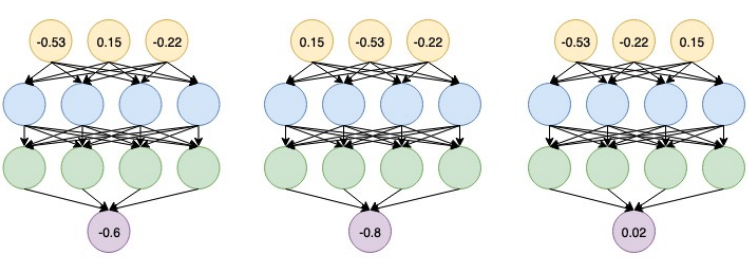
- 利用MLP实现GNN不符合预期

- Insights: 借鉴CNN,每次卷积操作只取某个点及其邻域点
模型结构
- 利用每个节点的邻域节点为每个节点建立计算图。nn的层数k代表用了k hop的邻域。
- 每个节点都有不同的计算图
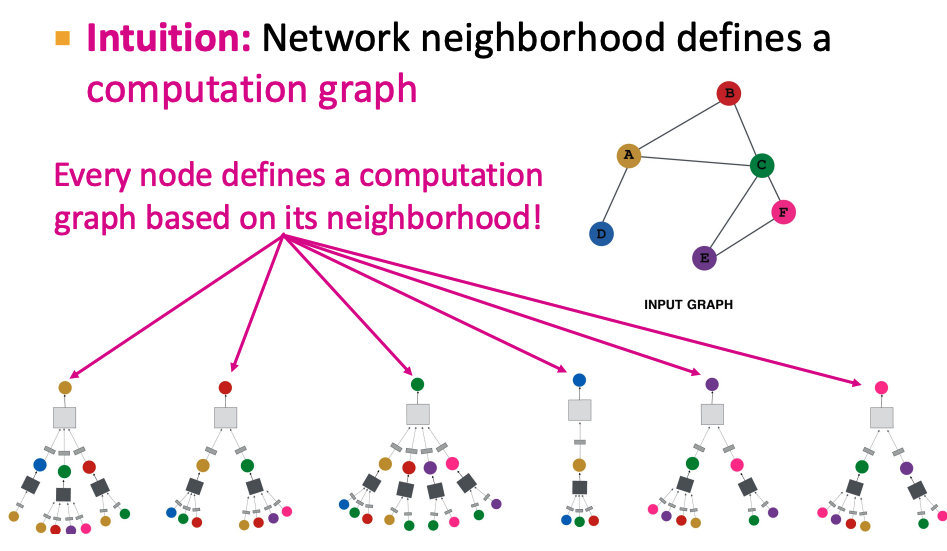
- layer0: node v的输入特征
- layerk: 经过了k跳后,node v的节点信息
模型参数
- 每一层包含两个阶段:信息aggregation & passing
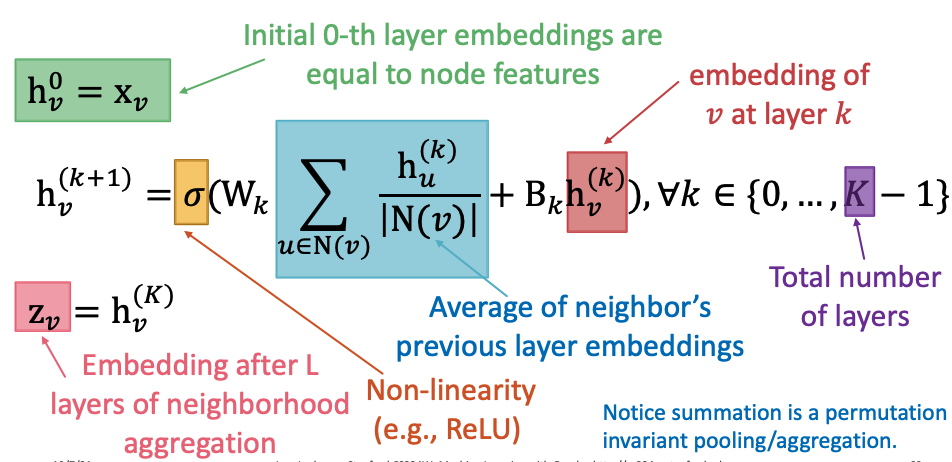
- 每层参数共享
- : the hidden representation of node v at layer k
- : weight matrix for neighborhood aggregation
- : weight matrix for transforming hidden vector of self
- 当aggregate为简单的平均时,可以转化为稀疏矩阵表达式 —》 稀疏矩阵便于优化
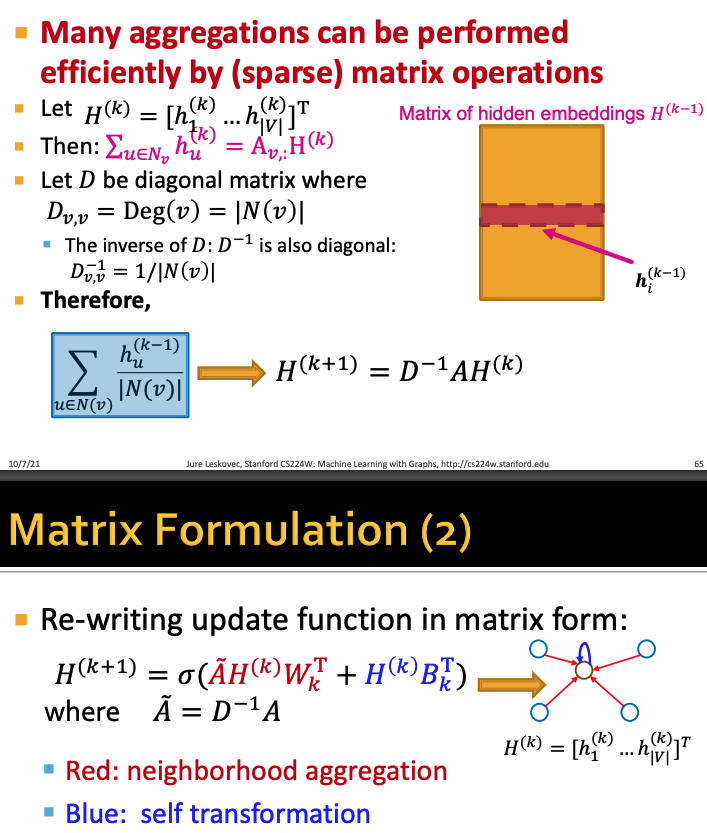
General GNN Framework
A Single GNN Layer
- Goal: Compress a set of vectors into a single vector
- Two steps:
- Message, v, 传送信息
- Aggregate
- others:
- Nonlinearity(activation):增加表达能力
- residual/attention/dropout/BatchNorm/…
Message
- 将l-1层的vectors过一个function,得到新的vectors,也称messages。对于每个node u:
- 比如使用线性层作为该函数:
Aggregation
- 对于节点v,将其领域内的所有messages聚合在一起
- principle: Aggregation需要满足排列不变性
Issues & Solutions
- Issue1: 只考虑了领域,节点本身的信息被丢弃了
- Solution1: 计算的时候,考虑 ,可以认为是node v有一个self-edge
- Issue2:
- Solution2: Residual
Classical GNN Layers
GCN(Graph Convolutional Networks)
- Message:利用出度作归一化。包含了self-edge。
- Aggregation: sum
GraphSAGE
- Message和Aggregation结合在一起,且做了多次Aggregation
- 先对neighbors做aggregate,再和node本身aggregate,之后再计算一次Message
- 邻域的Aggregation可以是Mean, pool, LSTM等
- l2 normalization: Apply l2 normalization to at every layer。标准化后,每个vector的l2 norm都为1
GAT
- 显式地获得不同邻域节点对目标节点的重要性
- attention计算
- attention系数计算:相似度/MLP
- 归一化: softmax
- 多头attention
- Pros
- Computationally efficien: attention系数可以并行计算所有的edges;aggregation可以并行计算所有nodes
- Storage efficient: 不超过O(V+E)
Stacking GNN layers
The over-smoothing problem
- all the node embeddings converge to the same value
- 每个node的embedding由其感受野决定,如果两个node的感受野重合的很多,其embedding越相近。而感受野由GNN的层数决定,层数越多,over-smoothing越严重
- Solution1: GNN层数的控制。先分析感受野大小,再根据所需感受野大小决定layers number
- Solution2: skip connections/residual。
- 相当于mixture of models. N次skip, 个可能的路径/模型
- Option1: 连到非线性前
- Option2: 连到下一层
提高GNN表达能力
- Solution1: make aggregation / transformation become a deep neural network!
- Solution2: 增加其他层(MLP/CNN等)
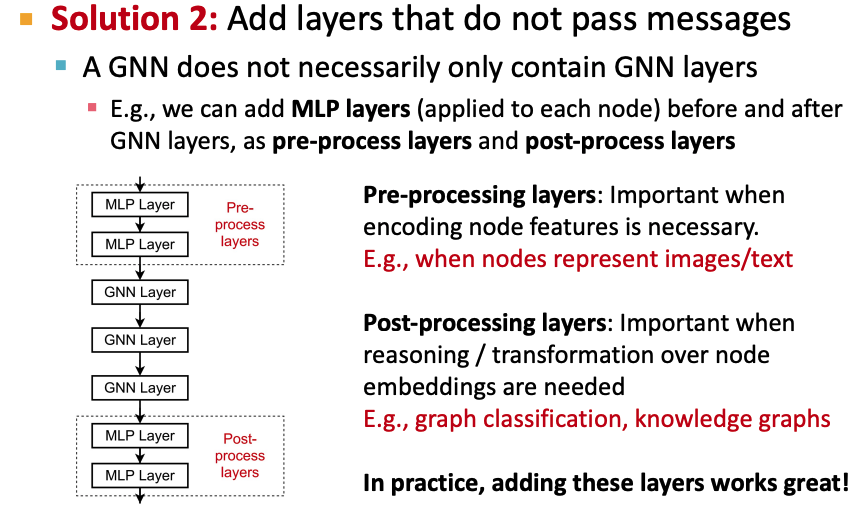
Graph Augmentation
- idea: raw input graph ≠ computation graph: 计算图不必和实际的图结构保持一致
Reason for augmentation
- 特征:原始图的特征可能比较少 —》 feature augmentation
- 图结构
- 图太稀疏:inefficient message passing —》 Add virtual nodes / edges
- 图太稠密:costly —》 Sample neighbors when doing message passing
- 图太大:GPU放不下 —》 Sample subgraphs to compute embeddings
Feature augementation
- one-hot/constant encoding
- others: 一般会使用:
- node degree
- clustering coefficient
- pagerank
- centrality
Sparse graphs augmentation
- add virtual nodes/edges
- Add virtual edges
- 例如在使用邻接矩阵A的时候,改为使用 ,A2相当于添加了virtual edges
- Add vitual nodes
Node neighborhood sampling
- 针对很稠密的图引起的costly问题
- 方案:sampling
- 对某个target节点,sample其neighbors
- sample target节点
GNN training pipeline
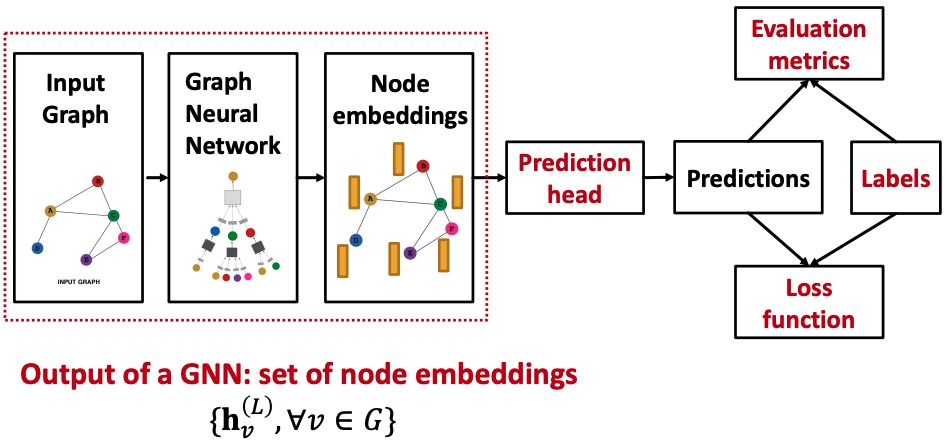
- 以上工作将计算得到set of d-dim node embs
- 还存在两个问题:
- 这些emb需要被应用在具体的任务中(前向过程需要完善)
- emb需要更新(反向传播需要定义)
Prediction heads
node-level
- 直接利用node embs,其中: map node embeddings from to so that we can compute the loss
edge-level
- 使用pair of node embs
- option1: concat+linear(map 2d-dim to k-dim)
- option2: dot product. 得到一个连续值,只能应用于二分类预测/一维回归
- option3: 多头的dot product,多个加权的option2
graph-level
- option1: global pooling
- option2: hierarchically global pooling
- 需要同时实现两个GNN任务:GNN A:计算node embeddings; GNN B:聚类
- 两个任务可以并行训练
- 为每一个cluster创建一个新的node,为相连的nodes创建edge,并生成一个新的pooled network

Loss defines
Dataset split
- 难点:graph的各个node/edge之间不满足iid假设。random split会带来information leakage。
- solution1(Transductive setting): 会有部分leakage。仅仅split node labels.
- At training time, we compute embeddings using the entire graph, and train using node 1&2’s labels
- At validation time, we compute embeddings using the entire graph, and evaluate on node 3&4’s labels
- training / validation / test sets都在同一个graph上。三个dataset组成一个graph。
- 可以应用在node/edge tasks。因为graph task需要在unseen graphs上做测试,而transductive方法无法满足。
- solution2(Inductive setting): We break the edges between splits to get multiple graphs。没有信息泄漏,图被分成了三个子图。
- At training time, we compute embeddings using the graph over node 1&2, and train using node 1&2’s labels
- At validation time, we compute embeddings using the graph over node 3&4, and evaluate on node 3&4’s labels
- training / validation / test sets不在同一个graph上。三个dataset组成是三个graph。
- 可以应用在node/edge/graph tasks
link prediction
- link prediction是无监督任务,需要定义label & split
- step1: 先划分message edges和supervision edges。其中supervision edges不入图,只作为label。
- step2: split
- Transductive method: 有四种edge: training message edges & training supervision edges & validation edges & predict test edges.
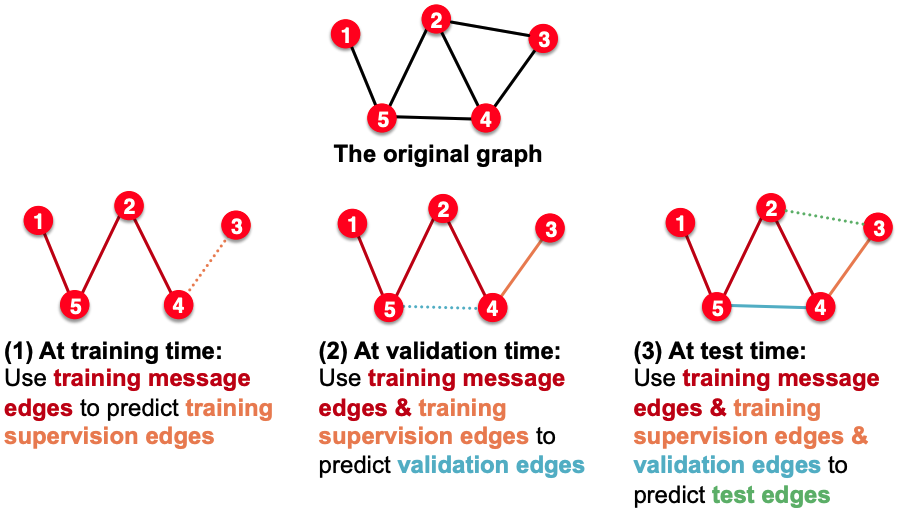
- Inductive method: In train or val or test set, each graph will have 2 types of edges。

Tips
- data processing: use normalization
- optimizer: adam is relatively robust to learning rate
- activation: relu
- bias term in every layer
- debug:
- 小数据集上,loss应该很小。如果underfit, something is wrong
- loss
- visualizations
- initialization
- adjust hyperparameters such as learning rate
性质
- 本质:假设将节点作为特征向量作为输入feed into MLP, 特征向量会包含邻域节点的信息,因此不能满足排列不变性,而GNN则是把节点的领域信息存在了NN结构里,因此每个节点都拥有自己的计算图/神经网络结构
- 流程:1)定义neighborhood aggregation function; 2) 定义loss function; 3) train; 4) generate node embeddings
- 权重矩阵共享:参数量为|V|的次线性
- Inductive(归纳式的):可以为没出现过的node生成embedding。由于权重矩阵W/B的共享,即使没有出现过的node,也可以为其生成计算图,进而生成embedding
- 可以为新的graph生成embedding,前提是new graph中的节点都出现在了old graph中
GNN VS MLP
- MLP假设IID,不同样本间独立,因此无需满足排列不变性
- Graph数据node间不独立,因此需要满足排列不变性
- 将node的特征向量作为输入,使用MLP —》 将graph的结构作为MLP的输入 —》 一般一个数据集就一种nn结构
- GNN —》 将graph的结构作为nn的结构 —》 一个graph有多种nn结构
GNN VS CNN
- GNN:
- CNN:
- 重写CNN:
- 从邻域选择讲,CNN是邻域确定的特殊GNN
- CNN不满足排列不变性,改变像素排列,输出也不同
- Transformer是针对序列数据的,一个序列中两个node互为上下文,因此可以看做是所有n ode都互相连接的graph
GNN Theory
- GNN表达能力的衡量,如何设计表达能力强的GNN
- 表达能力强的GNN能够为不同的节点生成不同的embedding
GNN的表达能力
- GNN的计算图:每个节点的有根子树
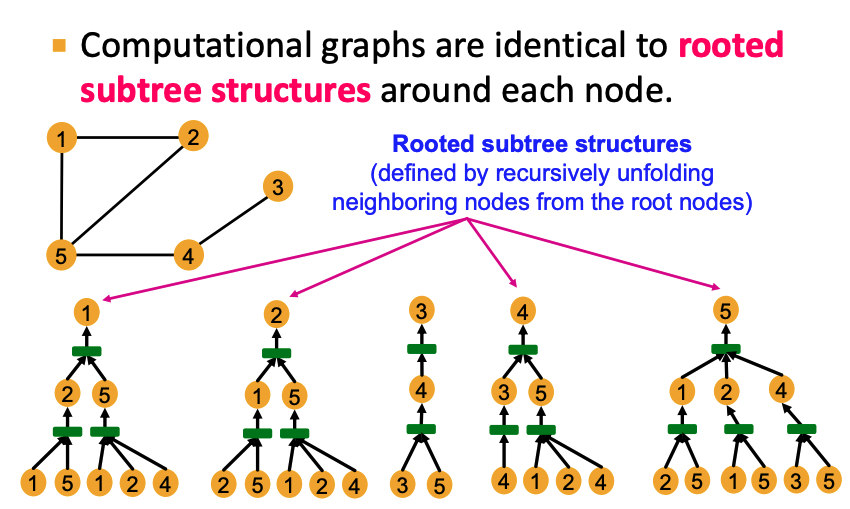
- Injective function: 内射函数。f(x)=Y,不同的X能映射为不同的Y,称之为内射函数
- 如果每一步的neighbor aggregation是内射函数,则GNN可以分辨不同的有根子树。
- GCN(mean-pool, ex. MeanPool([1,0],[0,1])与MeanPool([1,0],[0,1],[1,0],[0,1])一样)/GraphSAGE(max-pool)都不是内射函数
- Any injective multi-set function can be expressed as: , f和外层φ为非线性函数,中间是对multi-set做sum。而非线性函数可以用MLP来建模
GIN(Graph Isomorphism Network)
- THE most expressive GNN in the class of message-passing GNNs
- Apply an MLP, element-wise sum, followed by another MLP.
Refs










